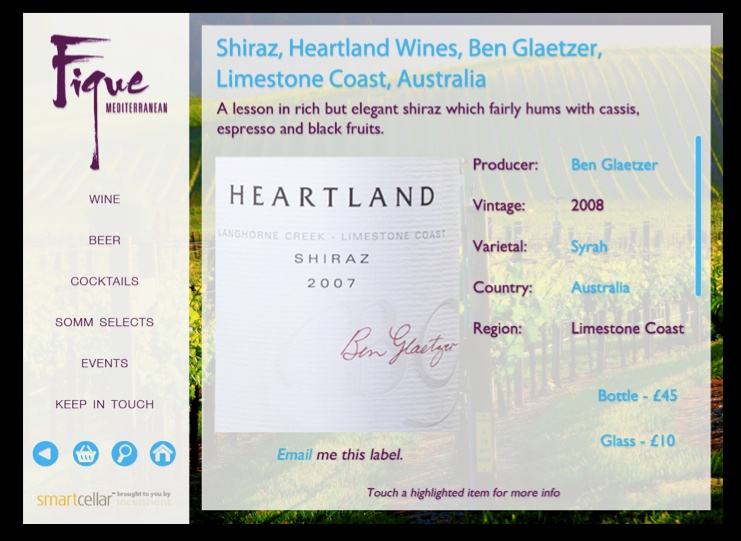10 creative ways businesses are using tablets

Tablets can provide a customized user experience that businesses can use to create better ways to interact with customers. You've probably heard about businesses using mobile devices to gather analytics on the shopping or buying behaviors of their customers, but there are other tablet usage stories. We've compiled a list of 10 creative ways companies are using tablets.
1. Interactive menus
Incentient specializes in guest services for the hospitality industry. They use an iPad interface to customize food and drink menus for clients all around the world. Wine lists are one of their specialities.
"We've been building the global wine database over the years," said Jennifer Martucci, co-founder of Incentient. "Every client can access and can sort by attributes they wish."
When the guest selects the wine, they have pairing suggestions, images of labels and tasting notes. The Incentient program also allows businesses to run analytics to find out exactly what guests are touching on the screen and eventually buying.

2. Concierge services
A concierge staff is typically for luxury hotels and resorts. Tablets change that by allowing hotels to use them as makeshift concierge stations. Instead of going down to the front desk to chat with the receptionist, guests can log into the hotel services on the tablet and book reservations, download and print boarding passes, and add notes for hotel employees. Concierge Interactive has clients like Four Seasons and Hyatt Regency, which use the service as virtual guides to their hotels.
3. Photo booths
Boothify is a custom photo booth that is downloadable for tablets for company parties and other events. Set up a light, prop up the tablet, put down a backdrop, and you've got a lightweight photo booth. Boothify, made by Prolific Interactive, is also a social media experience--it has a live feed of the booth's photos and it aggregates guests' photos on Instagram as well using a specific event hashtag.
4. Concerts and sporting events
Instead of servers running around the suites of arenas during concerts or sporting events, guests can use tablets to order food and beverages, shop the company store, or purchase tickets for future events. Some customizations offer places to visit after the event or scheduling of sober rides home. However, in the examples of these interfaces shown by Incentient, guests are only directed to certain websites and cannot generally browse the web or use the tablet for anything else.
5. Social bar games
With trivia, poker tournaments, karaoke, and apps for kids, bar games keep customers sticking around longer, therefore drinking and eating more and spending more money. Buzztime uses Samsung Galaxy tablets and a mobile app to offer bars and restaurants arcade games, card games, and trivia tournaments. Customers use the tablets at their table for individual or group games and receive branded rewards and targeted advertising.
6. Going beyond payments
Tablets as point of sale systems have been around for quite some time, but some companies are taking it one step farther. Starbucks, whose handy app allows customers to pay for their orders and use loyalty rewards programs through mobile devices, now offers customers the option to create a custom order on their smartphones and tablets before they even reach the register.
Both Chili's and Applebee's announced in 2013 that they are installing tablets at each table in many of their locations across the U.S. by spring 2014. Having the tablets at the table lessen wait times and ease the ordering and payment processes for customers. Applebee's is using E la carte Presto tablets, and Chili's is installing Ziosk.
7. Digital signage
Grocery stores and clothing retailers are among some of the most common types of businesses that have used digital signage for several years. However, using tablets for digital signage allows for a smaller and more personal, private experience for a variety of companies and their customers. Armodilo creates sleek tablet stands for digital signage for clients such as Macy's, TED, and Philips. The company makes freestanding iPad kiosks that come in many different shapes, sizes and colors. Many of their clients use the stands at research conferences and exhibitions as an addition to a booth or a stand-alone kiosk, but they are also useful inside stores to create an interactive experience.
8. Better equipping field employees
In manufacturing and installation businesses, there is a definite need for secure but flexible testing and payment systems. Employees may need to test products, run inspections, or install new systems. Tablets can make that process much faster, simpler, and more efficient. Take Maine-based Revision Energy for example, a company that installs solar-powered systems. The company equipped its employees with Google Nexus tablets so they can use them to create proposals and deploy the services. The company is also looking at cloud storage to sync information between them and their customers.
9. Pop-up retail shops
During the most recent holiday season, the pop-up shop trend exploded into the retail scene, especially with big technology companies. For a short amount of time around the holidays, Google, Microsoft, and Intel all opened pop-up stores across the U.S. and used tablets as the primary tool for sales, product searches, and customer interaction. Pop-up shops are an easy way to showcase these portable, lightweight tablets.
Intel's pop-up store was its first attempt at a brick-and-mortar store, called the "Intel Experience," which used tablets as the main avenue to interact with customers to show them product inventory, place orders, and offer games and social networking.
10. Specialized point-of-sales
Sephora, the beauty retailer, is exemplary in the use of tablets as point-of-sale systems. Employees are equipped with tablets that have a Sephora app complete with makeup tutorials, a virtual mirror, experts performing how-to videos, social media, catalogs, and loyalty programs. They carry it around the store, assist customers, and make the sale transactions wherever they are on the floor. The Sephora app connects via smartphones as well. The company also uses tablets as in-store kiosks in a partnership with nail salon XpresSpa. The tablets showcase menus of nail art, colors, and prices of manicures, which can then be done in-store or send tutorials for customers to use at home.